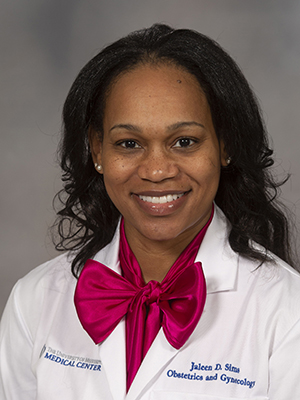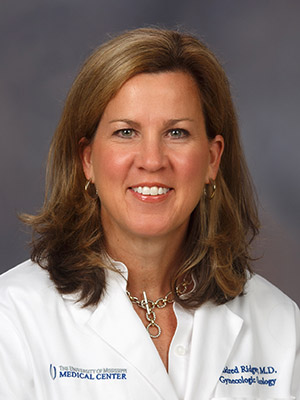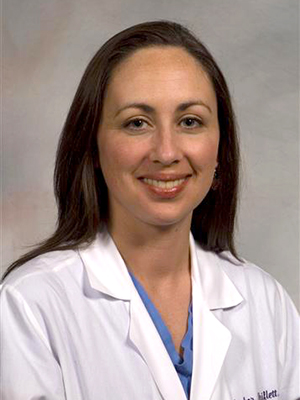Fibroid treatments improve fertility, quality of life
A grapefruit and a lemon. Bitter fruits, indeed. And coincidentally, the sizes of two fibroids detected in Johnlyn Rogers’ uterus, resulting in infertility, excruciating pain, heavier-than-normal menstrual bleeding that lasted more than two weeks each month, and FOGO (fear of going out).

The project manager for Academic Affairs in the School of Nursing was just 28 when Dr. Sheila Bouldin, professor of obstetrics and gynecology, diagnosed her with fibroids, muscular tumors that grow in the wall of the uterus.
“I had little to no interest or energy for activities other than work and household chores due to the prolonged bleeding,” said Rogers. “Eventually my fibroids increased in size and began to press against my bladder. In all aspects of life, I had to factor in having fibroids.”

Dr. Jaleen Sims, instructor of obstetrics and gynecology, was 34 when a pelvic exam revealed seven fibroids, one peach-sized lodged in the cavity of her uterus, which had ballooned to the size of a 12-week fetus, affecting fertility.

Because of the location of the fibroids and Sims’ fertility issues, Bouldin referred her to Dr. Mildred Ridgway, associate professor of obstetrics and gynecology, who performed a myomectomy, surgical removal of the tumors.
“Everything was expedited because my bleeding was significant, we wanted to get pregnant and I was knocking on advanced maternal age,” said Sims. “I found out about the fibroids in December and had surgery in January. I had already failed medical management at that point and was mildly anemic.”
As many as 80 percent of all women will develop fibroids by age 50, and they are most common in women in their 40s and 50s, according to the Department of Health and Human Service’s Office on Women’s Health. They are usually non-cancerous.
In addition to advanced age, women who are African American or have a family history of fibroids are most likely to develop the tumors.
The number of women Dr. Bouldin treats for fibroids has increased since she began practicing 20 years ago; it’s hard to pinpoint why because the exact cause of fibroids is unknown, she said.
“We see women presenting with fibroids earlier in African American women, often in their late 20s,” said Bouldin. “Some may not have any symptoms. Others experience menstrual irregularities such as heavy menstrual cycles with clotting, pelvic discomfort, severe menstrual cramping, urinary frequency, and lower back pain. These are often the issues that lead to women seeking medical attention.”
When Bouldin returned to Mississippi after completing residency training, most of her patients who’d had fibroids had already had hysterectomies, she said. Today, though hysterectomy, removal of the uterus, is still the definitive treatment for fibroids because of its finality, it is not an option for women who still desire to have children, said Bouldin.
“Women having problems conceiving because of fibroids should have a consultation with their gynecologist or a reproductive endocrinologist about the possibility of having fibroids removed by myomectomy,” said Bouldin. “They need proper counseling about potential of fibroids recurring, risk of hysterectomy, and risk of need for a C-Section delivery after myomectomy. Fibroids in pregnancy can grow and cause fetal growth restriction, preterm contractions, preterm labor, fetal malpresentation, and pain during pregnancy.”
Bouldin removed Rogers’ bitter fruits using a myomectomy, and four years later, she and husband Jimmy conceived, giving birth to a healthy baby girl, Elle Maree, now 18 months old.
After four intrauterine insemination cycles, in which sperm is placed directly into the uterus using a catheter, Sims, the OB-GYN, and husband Ray also welcomed a baby girl, Zoe, now 3.
Sims, though happy with her results, notes that her fibroids have started to return, which is not uncommon as myomectomy only removes existing tumors. It does not prevent reoccurrence.
“If they cause issues again, I hope I can control it medically,” she said. If medical options don’t work, she said she’ll likely opt for a hysterectomy.
— — —
Other treatments

While myomectomies are proven effective for women wanting to conceive, new medical and surgical treatments may help women who simply want relief from heavy bleeding, said Dr. Amber Shiflett, associate professor of obstetrics and gynecology.
FDA-approved pills elagolix and relugolix work by decreasing the amount of certain hormones in the body, she said.
“Both are designed to decrease heavy menstrual bleeding in patients with fibroids who do not have a contraindication to hormonal therapy,” said Shiflett. “Data suggests they both can decrease heavy bleeding by up to 50 percent. Coverage has been an issue and has limited my use of the drugs.”
Bouldin, who anticipates promising results from elagolix, said she is excited to prescribe oral medications for fibroid-related bleeding now that pharmaceutical companies are addressing availability due to coverage.
Bouldin has also successfully used uterine artery embolization, in which particles are injected into the blood vessels that cut off blood supply to the tumors, resulting in shrinkage.
Two other treatments, magnetic resonance imaging-guided ultrasound surgery, which uses ultrasonic pulses to heat and destroy tumors, and radiofrequency ablation, in which a needle-like probe shrinks the tumors, are not yet available at UMMC.
Though women are increasingly conservative at exploring less invasive options than the tried-and-true hysterectomy, the surgical procedure, which is performed on roughly 600,000 women a year, is still the most popular treatment for fibroids.
In fact, about 80 percent of the hysterectomies Dr. Bouldin performs are in response to complaints about pain and heavy bleeding from fibroids.
Some fibroids don’t require treatment, but women who have not yet shown symptoms should be proactive, said Bouldin, who herself was diagnosed with small fibroids in her 40s during a routine annual exam. Though asymptomatic, she monitored their size periodically through ultrasound.
“My best advice to women diagnosed with small fibroids and are asymptomatic is to keep a menstrual diary, make regular preventive gynecologic visits, stay in tune with your body, and maintain a healthy lifestyle and diet,” said Bouldin.
The above article appears in CONSULT, UMMC’s monthly e-newsletter sharing news about cutting-edge clinical and health science education advances and innovative biomedical research at the Medical Center and giving you tips and suggestions on how you and the people you love can live a healthier life. Click here and enter your email address to receive CONSULT free of charge. You may cancel at any time.



